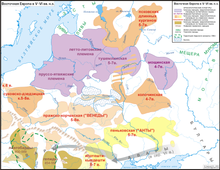Tuschemlja culture
The Tuschemlja culture or Tuschemlja-Banzerow culture (Russian Тушемлинская культура or Тушемлинская-банцеровская культура ) was an archaeological culture of the late Iron Age from 4th to 7th century in what is now Belarus and western Russia .
It follows on from the Dnieper Dvina culture and has influences from the line pottery culture and the Kiev culture .
Distribution area
The distribution area was in today's Belarusian Oblast Mahiljou and Minsk , as well as the Russian Oblast Smolensk . The culture is named after the Tuschemlja ramparts on the Tuschemlja River near the village of Mokryadino in Smolensk Oblast and the ramparts in the village of Banzerowschtschina near Minsk .
The area corresponds roughly to the settlement area of the Slavic (or Baltic) Kriwitschen tribe, which is documented at the latest for the 9th century .
Settlements
In addition to simple settlements, there were also refugee settlements that were apparently later destroyed by fire.
economy
Iron was an important material. There were swords of various shapes, axes, knives with straight blades, arrows and the like. a.
Research history
The culture was discovered in the 1950s, and AG Mitrofonow recognized the similarities between the Tuschemlja and Banzerow cultures in the 1960s .
literature
- Aleksej Grigoryevich Mitrofanow: Archeologitscheskije pamjatniki vostochnych baltow na territorii Belorussii w epochu shelesa ( Archaeological Cultures of the Eastern Balts in Belarus in the Iron Age ). Minsk 1980
Web links
Remarks
- ↑ The Banzerow culture ( page no longer available , search in web archives ) Info: The link was automatically marked as defective. Please check the link according to the instructions and then remove this notice.
- ↑ Tarasov I. The balts in the Migration Period. PI Galindians, p. 97.
